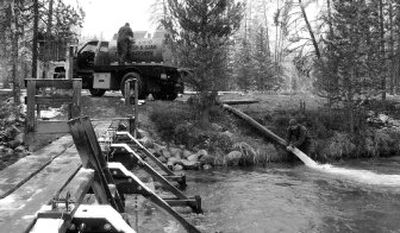Hatcheries’ role changing

BOISE – Fishery biologists in the Pacific Northwest are in the midst of a high-stakes course change on how hatcheries operate, a move intended to boost flagging runs of wild salmon and steelhead.
But some are concerned expanding attempts to raise wild fish in hatcheries could push the runs nearer extinction by genetically weakening them, or diluting the runs to such an extent with hatchery influence that they are no longer wild.
“There’s kind of a wave of change that’s slowly permeating through the fishery community, and it goes by the phrase ‘hatchery reform,’ ” said Don Campton, a senior scientist with the U.S. Fish and Wildlife Service.
He dates the push toward hatchery reform to the early 1990s, an era he describes as “hatchery bashing,” and the beginning of a wave of Endangered Species Act listings of salmon and steelhead runs.
Up to then more than 100 hatcheries in the Columbia River Basin had been built mainly to offset the declines in salmon runs caused by loss of habitat to dams, irrigation, logging and urban development.
Now, the mission of many of those hatcheries has been at least partially changed with the goal of preserving wild runs.
“Run wrong and a hatchery can do a lot of damage to natural stocks,” said Bob Lohn, regional administrator of the National Oceanic and Atmospheric Administration Fisheries Service. “Run right and they can do a lot to sustain them.”
Besides changing existing hatcheries, new hatcheries are being built specifically to bolster native runs.
These supplementation programs sometimes use all wild fish, and sometimes a mixture of wild and hatchery fish. Sometimes only hatchery fish are used to reintroduce fish to streams where they are extinct but habitat has been restored.
But it gets tricky. A hatchery program might reduce the fitness of the wild run while increasing the productivity of the stream.
“There are definitely unknowns here on how everything balances out,” said Reg Reisenbichler, a research fisheries biologist at the Western Fisheries Research Center in Seattle. “How do you do all this and get the maximum benefit from the stream?”
Researchers have found that too much emphasis on hatchery fish can have diminishing returns.
“We have data that show – especially for steelhead the data is quite compelling – that hatcheries domesticate stock,” said Reisenbichler.
Outside the hatchery, the fish are quickly turned into snacks for other fish and birds.
But Campton said a hatchery can produce ten times as many salmon and steelhead as a spawning stream.
So federal, state and tribal hatcheries are running supplementation programs designed to combine greater hatchery numbers with the street-smart genetics of wild fish, in hopes of restoring runs while still providing enough fish for sport, commercial and tribal fishermen.
“We definitely think they are good, the tribes operate several of them,” said Jeremy FiveCrows of the Columbia Intertribal Fish Commission. “We just want to have the numbers back. The goal of the tribes is to put fish back in the rivers and protect the waters where they live.”
Studies to determine the success of those programs are under way.
The Idaho Supplementation Study includes the Clearwater and Salmon river basins in an experiment with chinook salmon. Thirty streams – divided between those with supplementation and those where only natural production is allowed – are in the study that began in the early 1990s and won’t be complete until 2012.
“One of the things that has been very apparent is you have to look at it on a case-by-case basis,” said Sharon Kiefer, anadromous fish manager for the Idaho Department of Fish and Game. “There doesn’t appear to be one method that works in all cases that is consistent across all experiments.”
“Some of these salmon and steelhead stocks are in such dire straights that we need to do something extra to give them a little bit of a jump start,” said Jack Williams, a senior scientist with the conservation group Trout Unlimited.
But Bill Bakke of the Native Fish Society said the hatchery approach to boosting salmon and steelhead runs fails to consider the main problem.
“The solution is to first of all protect the wild runs themselves, and protect the habitat that is supporting those wild runs,” he said. “There’s no shortcut.”
Thirteen Columbia River Basin fish populations are protected by the Endangered Species Act, and some of them are in supplementation programs.
“If you look across the landscape, there are supplementation experiments going on throughout the Columbia Basin,” said Kiefer. “I think at the end of the day, we’ll find some have worked and some have not.”